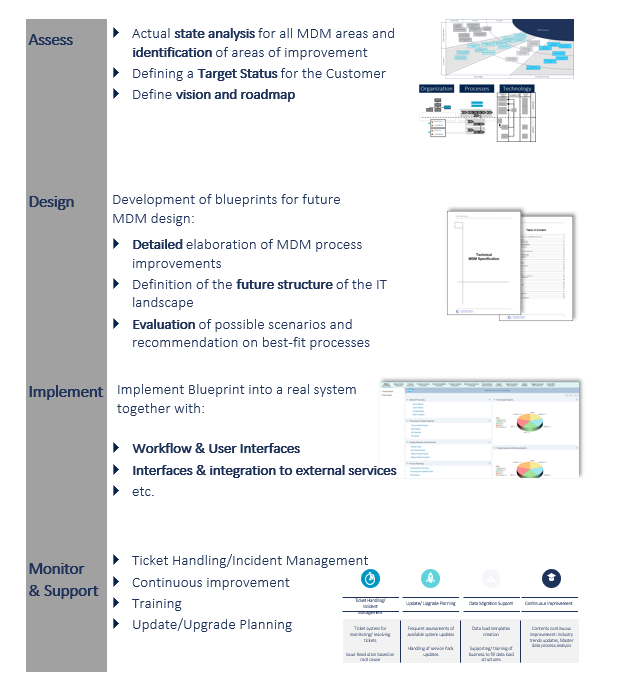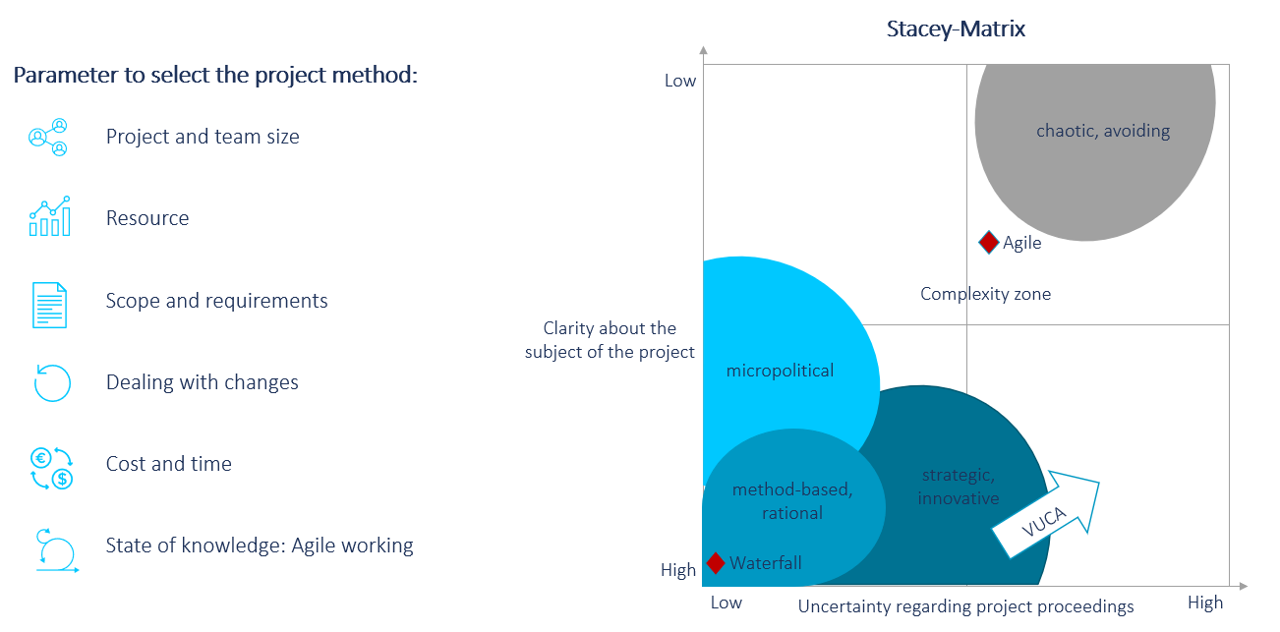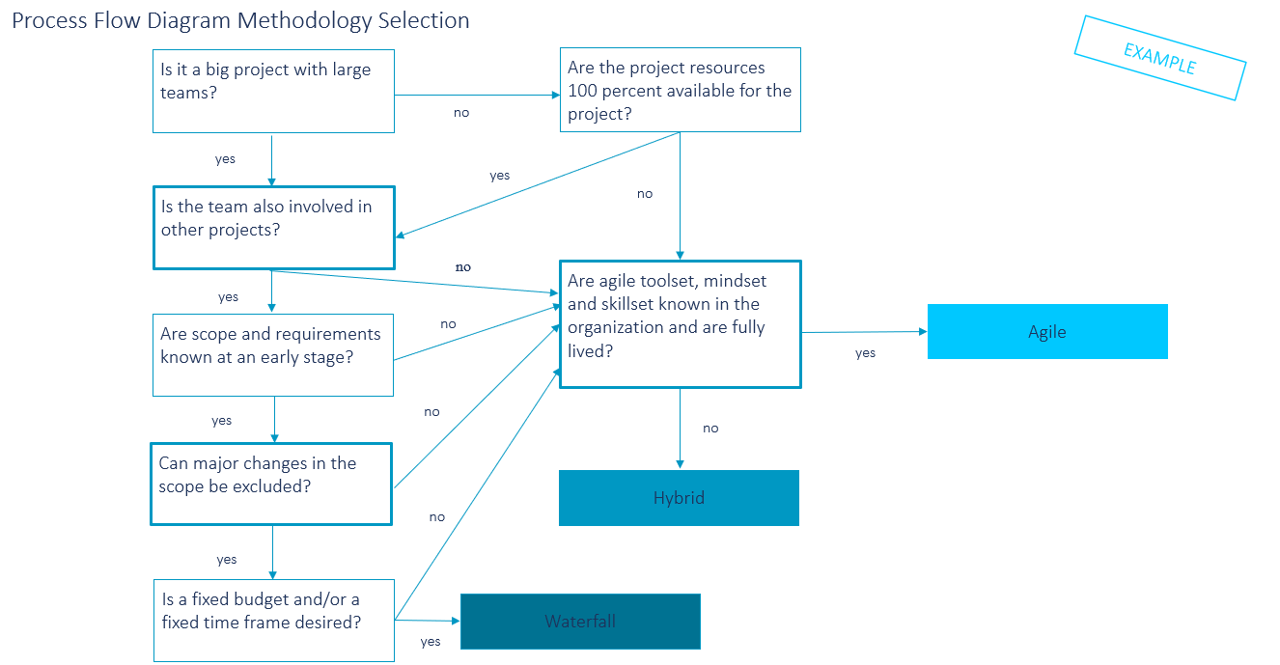52 percent of all projects in the IT environment fail to meet their timeframe and budget due to inappropriate methodologies. The conscious use of agile and hybrid concepts is a success factor, especially for data projects. This article illustrates parameters that influence the choice of methodology.
Successful project implementation up to the creation of a final product offers great added value for a company. The appropriate project methodology, therefore, needs to be consciously chosen. In recent decades, the trend has been toward agility. However, in their pure form, agile methods are not suitable for every company. A needs-based mix of different methods has proven to be particularly successful in our projects. But when should you choose classic, agile or hybrid project management? At the latest when a company sets up a data project, it should be clear which project methodology will be used.
Agile Working under New Requirements
Originally, agile project management, like other project management methods, was developed for teams that are physically located in one place. Characteristics of agile project management, such as fast, uncomplicated communication and efficient as well as needs-based adaptation of working methods, could be coordinated at short notice. As work became increasingly remote during the Covid-19 pandemic, agile working changed further. Before the crisis, agile projects were 60 percent more likely to succeed than non-agile projects (Standish Group, 2018). On closer inspection, “waterfall” projects are three times more likely to fail than agile projects.
So should everything be agile only from now on?
Even after the crisis, the high likelihood of success of agile projects compared to classic “waterfall” projects continues to speak for itself. However, this begs the question: Under what general conditions should the advantages of agile project management methods be used?
Selecting Project Methodology Efficiently – the Right Moment
Projects are typically divided into the project phases Assess, Design, Implement and Monitoring & Support (see Fig. 1). The initial Assess phase is crucial for the selection of the appropriate project methodology. Here it is important to understand the organization in its entirety. The current state must be determined and an initial picture of the project partner’s organization must be identified. Then a target state can be defined, which is to be pursued with the help of a vision, strategy and roadmap. This first phase allows an assessment of the appropriate choice of methodology. The right parameters should be taken into consideration in order to propose a methodology and make a decision in a time-efficient manner.

Which Parameters Play a Role in the Choice of Methodology?
We live in an increasingly volatile world, making clarity on project issues and uncertainty about how projects work more complex. The appropriate methodology, therefore, needs to be well considered and chosen with the help of certain parameters. Our experience has shown that the following parameters have an influence on the choice (cf. Fig. 2):
- Project and team size,
- Resource utilization,
- Scope and requirements,
- Dealing with changes,
- Costs and time required, and
- Knowledge of agile working.
In addition, other secondary parameters can be used as a supplement. These include: industry, IT landscapes, the day-to-day business of the client, the complexity of the processes and the type of contract (fixed price or time & material). How should the parameters be defined for an agile or hybrid approach to appear more promising than classic methodologies?

The Right Questions to Ask when Deciding on the Project Methodology
The questions in the process flow diagram below (see Fig. 3) may help you to choose the most suitable methodology. In each case, you must decide whether the question provided applies or not. The questions are based on the selected parameters. Furthermore, they can be defined and interpreted specifically for each user.

To prevent misunderstandings from leading to an inappropriate methodology, it is important to provide a definition framework for the process flow diagram. This can be based on the following conditions, for example. Depending on which answer applies, advantages of certain methodologies come into play:
- Team size: Is it a large project with large teams? Large projects have a high budget (more than 1 million euros) and the teams have more than five members. The project structure can be included in this question (i.e. the number of external and internal employees). Classical methodologies, for example, are suitable at first glance for projects of small scope and short duration.
- Resource utilization: Are team members heavily involved in other projects during the project? Are the project resources fully available to the project? If team members are involved in different projects, their capacity per project will presumably be lower. Fixed teams and little staff turnover in projects are a crucial factor in agile practices that can minimize resource conflicts.
- Scope and requirements: Are the scope and requirements known early on? It is helpful to ask whether the scope has been set down in writing and whether requirements are documented.
- Changes in scope: Can major changes in scope be ruled out? Vague wishes and requirements at the beginning of the project increase the risk of major changes during its course. If a high degree of unpredictable changes is likely in the course of the project, agile methodologies are suitable.
- Costs and effort: Is a fixed budget or schedule desirable? The type of contract can be used as an indicator here. While classic methodologies allow for variable costs and times, agile approaches are based on a fixed time and cost framework.
- Knowledge of agile working: Are an AGILE MINDSET, a toolset and a skillset available in the organization? It is important to assess to what extent the basis for agile working is available in the organization of the company. Agile know-how must also be LIVED in the company in order to complete a project successfully with agile methods. Additional training in agile working would be an effort that would go beyond the timeframe and budget of a project.
Only in the rarest of cases would the decision be made to use a purely classic approach, such as the waterfall method. This is because requirements are often unknown or only become clearer in the course of the project. They can also change as a result of new experiences or framework conditions. Our business environment has long since ceased to be stable and predictable; instead, we live in a volatile, complex world. The acronym VUCA is threatening to become one of many in the game of buzzword bingo, but in light of emerging conflicts and a pandemic, the term could not be more apt. In addition, besides changes in scope, the agile mindset, skillset and toolset know-how must also be considered a critical point in the process flow (Fig. 2).
Why Is It that Hybrid Models Are Often Chosen for Data Projects?
In data and analytics projects, the Assess and Design phases are often carried out using the classic waterfall method, and the project is then continued using SCRUM approaches. This hybrid approach combines the advantages of the plan-driven, structured approach of the classic method with a lot of documentation at the beginning of a project and follows the agile approach with room for flexibility and adaptability in the implementation phase, as increasing uncertainty is to be expected here. Often such a hybrid approach is the solution for projects in which the agile mindset is not fully lived in an organization or the skills or toolset for agile strategy development are not yet available. However, if this is the case, projects can also be carried out in a purely agile way. The trend towards increasingly agile working and the ever more complex environment highlight the chances of success such methods offer going forward. Very few projects are still run purely according to classic methods. Ultimately, it all comes down to choosing the right project methodology for the various data projects.

